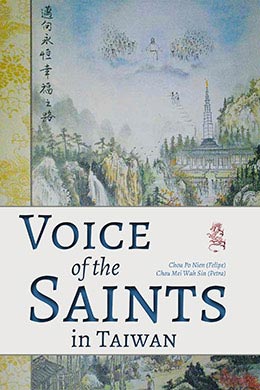Jubilee Celebration
New Buildings, Scriptures, and the Fiftieth Anniversary (2004–8)
Chou Po Nien (Felipe) (周伯彥) and Chou Sin Mei Wah (Petra) (周冼美華), “Jubilee Celebration: New Buildings, Scriptures, and the Fiftieth Anniversary (2004-08),” in Voice of the Saints in Taiwan, ed. Po Nien (Felipe) Chou (周伯彥) and Petra Mei Wah Sin Chou (周冼美華) (Provo, UT: Religious Studies Center; Salt Lake City: Deseret Book, 2017), 357-392.
This season of the Church in Taiwan marked the two hundredth anniversary of the birth of the Prophet Joseph Smith. In addition, new building projects of the Church in Taiwan, which included the new multipurpose Church Administration Building in Taipei and new stake centers, provided additional facilities for the increasing number of Taiwanese Saints. In 2006, the Church in Taiwan acelebrated its fiftieth anniversary, which included an island-wide youth conference and bicycle relay, helping to further prepare the rising generation of Taiwanese Latter-day Saints. Thereafter, the Church introduced the newly revised translation of the Chinese scriptures and key Church terminology. The Church created its one hundredth congregation in Taiwan, and it was also recognized by the Taiwan president.
Family Values Award and Two Hundredth Anniversary of Joseph Smith’s Birth
On 30 October 2004, Elder Ho Yu-Chen (Philip) (何於振) presided over the first ceremony for the Family Values Award in Taipei. President Chao Chiung Ming (James) (趙炯民), the stake president of the West Taipei Taiwan Stake, conducted this meeting. Members prepared and presented special musical numbers and talks. The first two individuals to receive this award were Professor Tai Dong Yuan (戴東原) of the National Taiwan University Hospital and Ms. Chien Bi Ying (簡壁鶯), who cared for her daughter with a severe hearing disability. The Church believes that the family is the basic unit of society and that the family can solve current social problems faced by the world. The Family Values Award presented by the Church recognizes individuals that promote family values in their community.[1] Liao Ji Shuen (廖吉順), the stake president of the West Taichung Taiwan Stake, first met the missionaries after seeing a flyer about the family. He said that the Family Values Award given to nonmembers once a year helped to share the gospel and promote the family.[2]
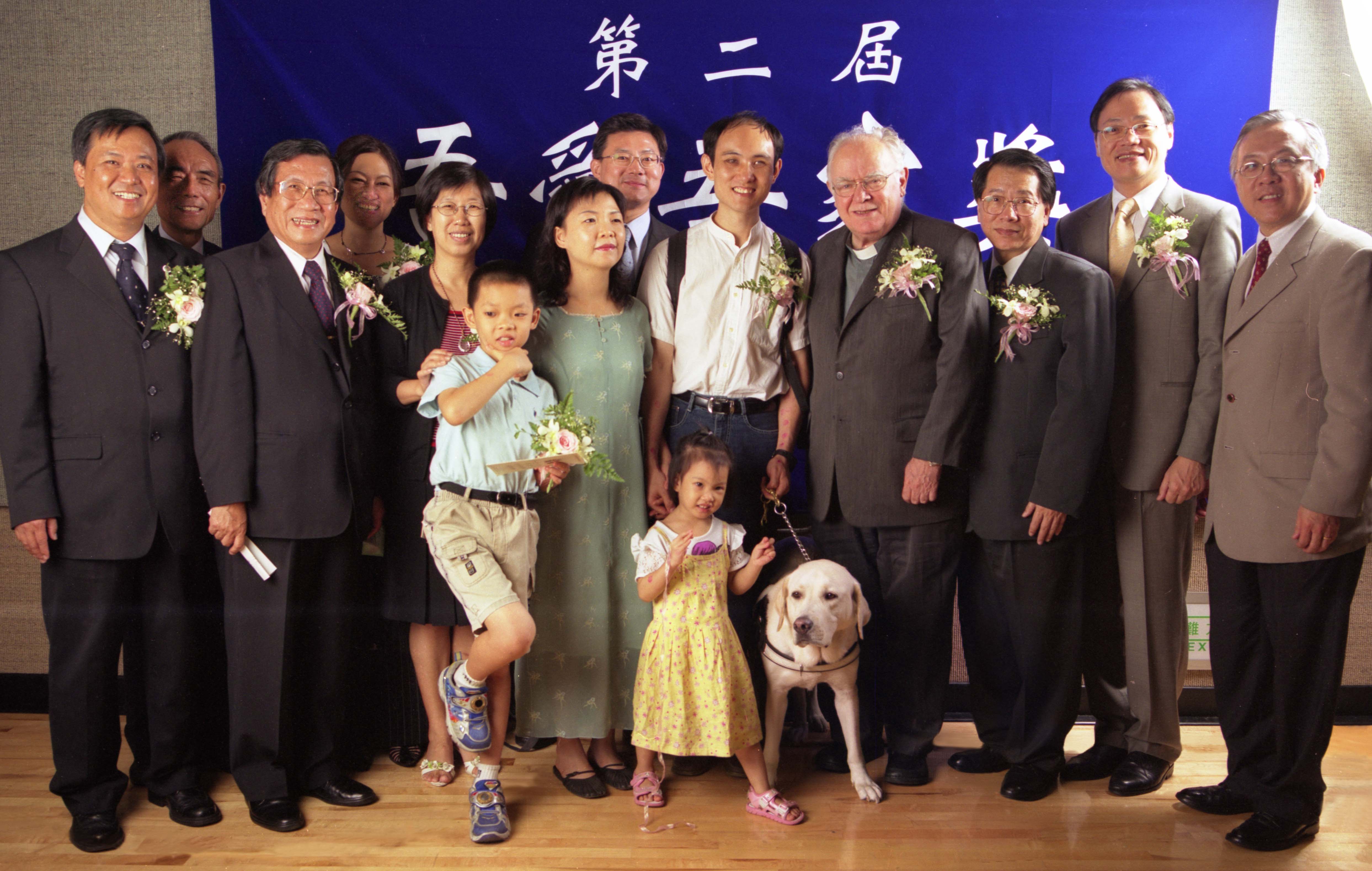 The LDS Church presents the first Family Values Award in 2004 and 2005. Courtesy of Taipei Church History Center.
The LDS Church presents the first Family Values Award in 2004 and 2005. Courtesy of Taipei Church History Center.
In 2005, President Hinckley announced his plan to travel to the Prophet Joseph Smith’s birthplace in Vermont to commemorate the two hundredth anniversary of his birth in December 1805. Other members of the First Presidency and the Quorum of the Twelve would join the celebration broadcast from the Conference Center in Salt Lake City, Utah.[3] A special bookmark was created by the Church to celebrate this event. This bookmark provided key events in the life of Joseph Smith. Brother Chou Po Nien (Felipe) (周伯彥), then the Church Educational System director for Taiwan, held special firesides in Kaohsiung and Taichung during the summer of 2005 to commemorate the life of Joseph Smith.[4] Meanwhile, Elder Liang Shih-An (Kent) (梁世安) helped to organize and coordinate a forum at a university in Taipei, providing an opportunity for scholars to examine and discuss the life and teachings of Joseph Smith.[5]
Multipurpose Church Administration Building & Other Construction Projects
During the early 2000s, the members of the Church in Taiwan were also blessed by the construction of new stake centers and buildings, as well as the new Church Administration Building in Taipei. Following the request by President Cree-L Kofford and the Asia Area Presidency, the Church purchased several tracts of land and began several building construction projects in Taiwan. These projects included the tearing down of the first chapel built in Taiwan at Chin Hua Street to make room for a new four-story multipurpose Church Administration Building, as well as five new stake centers or buildings throughout Taiwan.[6]
Chao Chiung Ming (James) (趙炯民), then manager of the Taiwan Service Center, accompanied Bishop H. David Burton, then the Presiding Bishop of the Church, to look at several sites. After viewing the proposed land in Chupei, Hsinchu, Bishop Burton asked about the adjacent property that was twice as big. Likewise, while visiting the proposed site in Kaohsiung, Bishop Burton again inquired about the adjacent land. In both cases, the Church purchased additional property.[7] Yang Shih-Ning (楊世寧), then a counselor in the Kaohsiung Taiwan Stake presidency, recalled that when President Kofford saw the proposed property in Kaohsiung, he proposed buying the adjacent property as well. Yang also reported that when Bishop Burton saw that property, he was encouraged and asked if the owner would be willing to sell the adjacent property. Then he added, “Which side is facing east?” Yang remembered that most temples face east, and he felt that perhaps a temple may one day be built on the adjacent property purchased.[8]
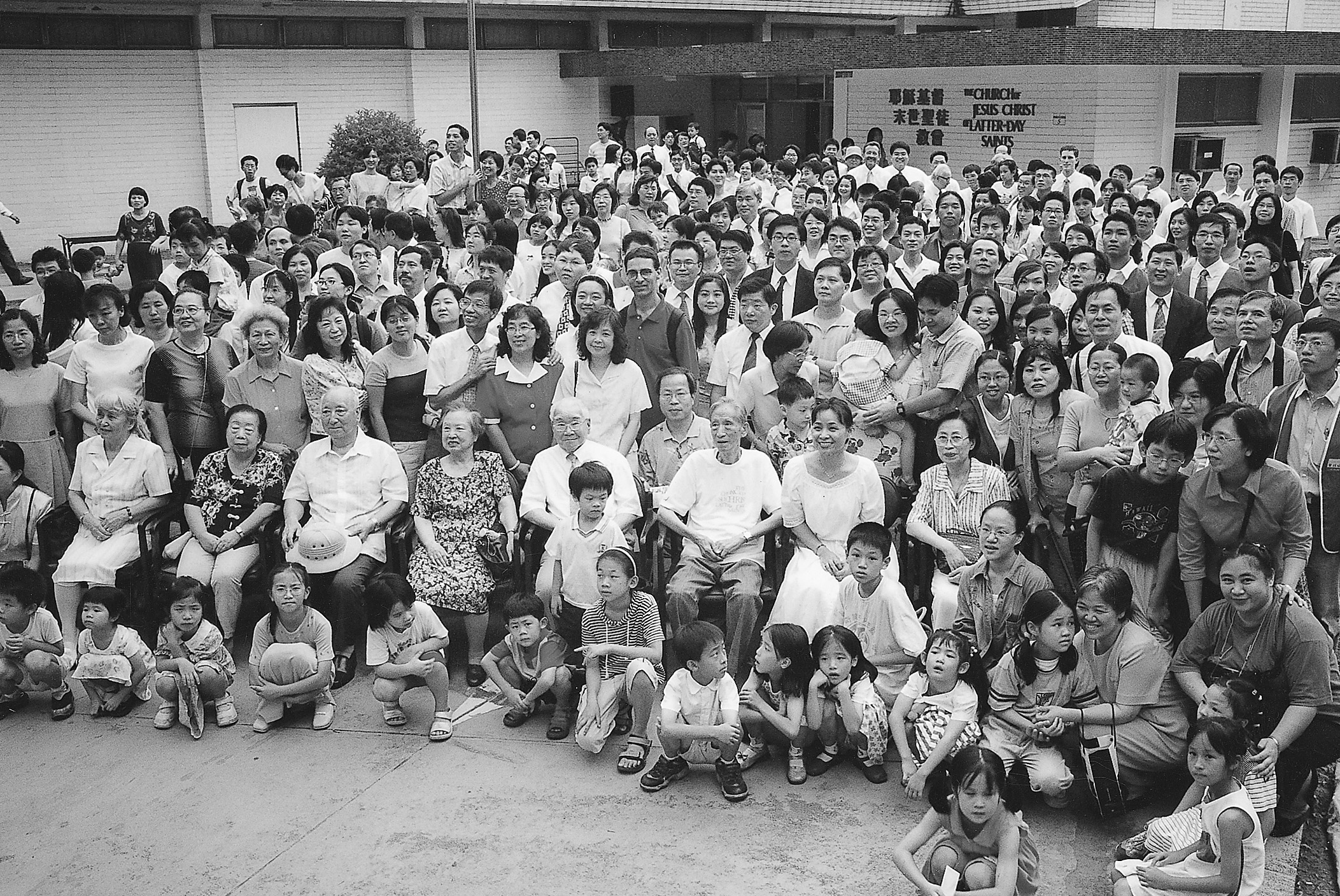 Special remembrance activity for the Chin Hua Street chapel in 2002. Courtesy of Taipei Service Center.
Special remembrance activity for the Chin Hua Street chapel in 2002. Courtesy of Taipei Service Center.
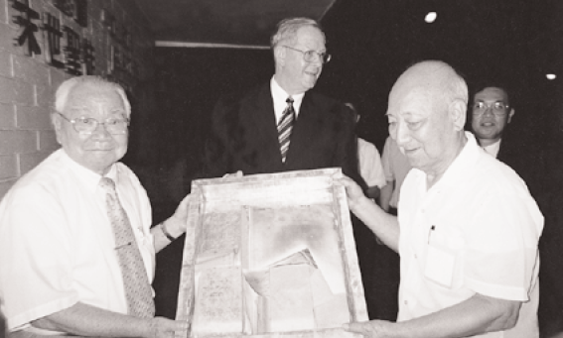 Elder H. Bryan Richards (Asia Area President) is assisted by Liang Jun-sheng (left) and Chen Meng-Yu (right) to open the time capsule during a special remembrance activity in 2002. Courtesy of Taipei Service Center.
Elder H. Bryan Richards (Asia Area President) is assisted by Liang Jun-sheng (left) and Chen Meng-Yu (right) to open the time capsule during a special remembrance activity in 2002. Courtesy of Taipei Service Center.
The Church in Taiwan held a special remembrance activity for the Chin Hua Street chapel before it was torn down. On 29 June 2002, President H. Bryan Richards, the Asia Area President, joined early pioneers of the Church in Taiwan in opening the time capsule within the old Chin Hua Street chapel. A special DVD was produced for the event which focused on the virtues of remembrance, gratitude, and hope. Elder Liang Shih-An (Kent) gave the dedicatory prayer for the groundbreaking ceremony for the new building. Various leaders and members were in attendance.[9] Many of the early Taiwanese pioneers of the Church shed tears as this historic chapel was torn down, but they sustained the decision of Church leaders and understood that the demolition would allow for a large multipurpose and multistory building to be built to meet the needs of the growing Church in Taiwan. Construction carried on for the next two and a half years.
On 15 January 2005, the Church held an open house for this new building, which would also serve as the new Taipei multistake center. The open house was presided over by President B. Dickson, then the Asia Area President, and various community leaders and news reporters attended. The new building included three underground garage levels, a Church distribution center, four floors above ground, two chapels and facilities for four local wards and an English unit, and stake and ward offices. Included on the third floor were facilities for the Seminaries and Institutes of the Church, as well as offices for the Taiwan Service Center located on the fourth floor. On 22 January, a special multistake musical program was held to celebrate the new building.[10] This new building included classrooms, chapels, a cultural hall, offices, and facilities for the Taiwan Service Center and Church education.[11]
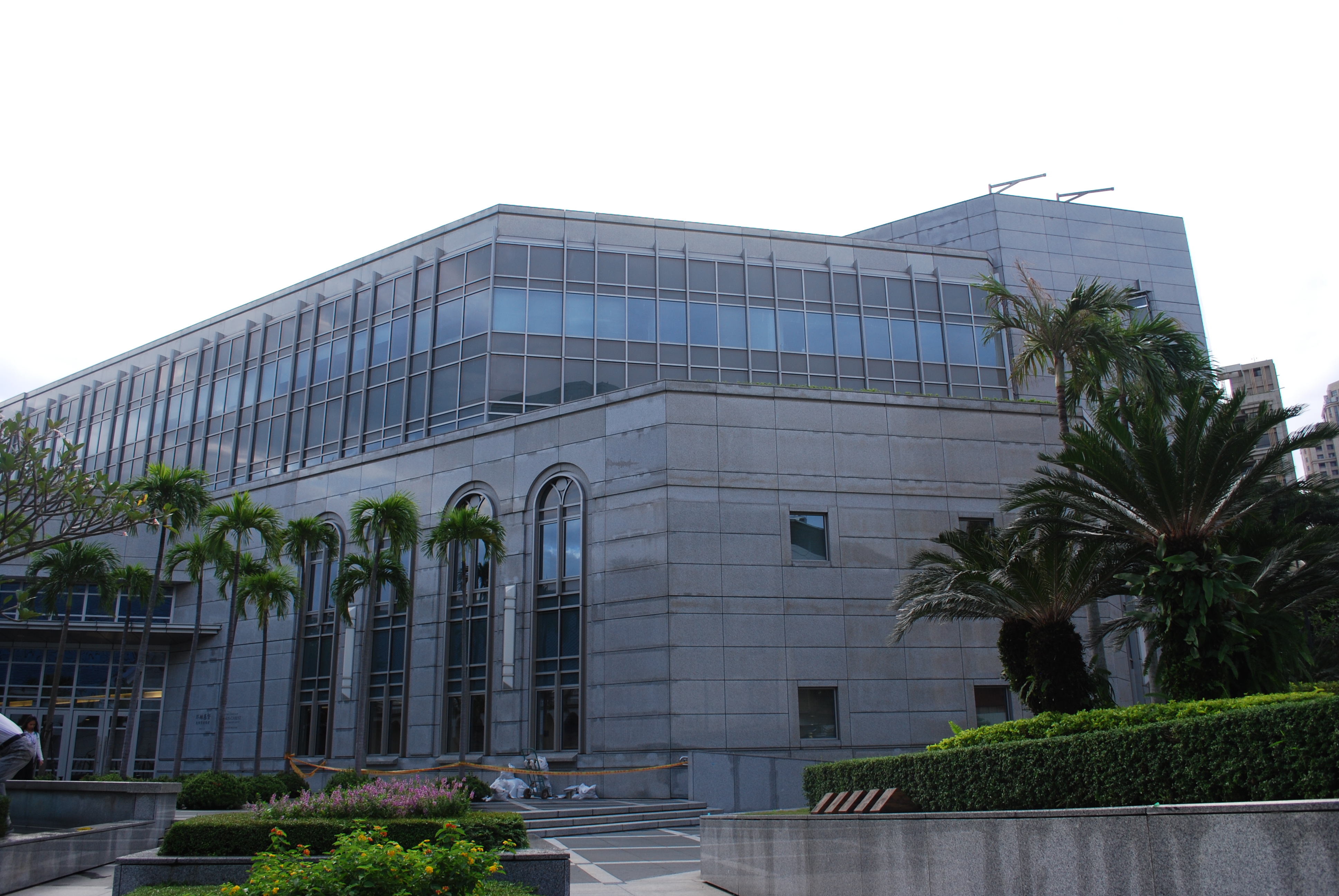 Multipurpose Church Administration Building in Taipei in 2015. This building was completed in 2005. Courtesy of Chou Po Nien (Felipe).
Multipurpose Church Administration Building in Taipei in 2015. This building was completed in 2005. Courtesy of Chou Po Nien (Felipe).
On 1 August 2005, President Gordon B. Hinckley visited Taiwan to dedicate the new Church Administration Building in Taipei. He was accompanied by Presidents Daryl H. Garn and D. Allen Andersen of the Asia Area Presidency and Elders Yang Tsung-Ting (Jared) (楊宗廷) and Ho Yu-Chen (Philip), who were Area Seventies.[12] President Hinckley addressed some 1,200 members prior to dedicating the new Church Administration Building. Members in Taipei described the meeting as a time filled with wonderful memories, laughter, and tears.[13] When President Hinckley spoke, Wang Ling-Xing (王令行) recalled a witness he received in 1996 that was reconfirmed again at this meeting in 2005 that “this is the Lord’s prophet.”[14] The Saints in Taiwan welcomed the prophet at the dedication of this “new building containing offices, a chapel and other facilities for Church members.”[15]
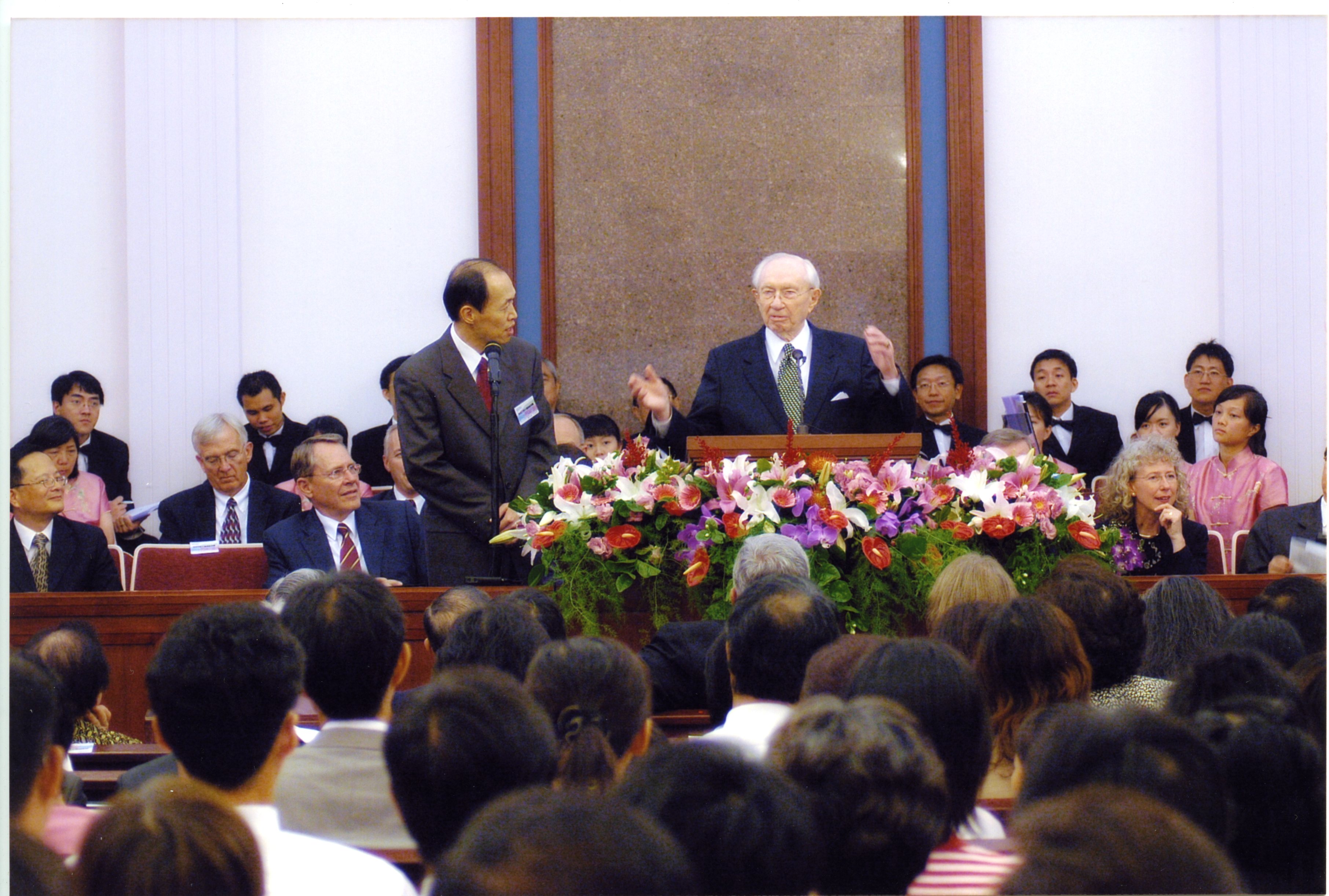 President Gordon B. Hinckely visits Taiwan to dedicate the new Church Administration Building in Taipei on 1 August 2005. Courtesy of Taipei Church History Center.
President Gordon B. Hinckely visits Taiwan to dedicate the new Church Administration Building in Taipei on 1 August 2005. Courtesy of Taipei Church History Center.
President Hinckley, who dedicated the Chin Hua Street chapel in 1966, would preside and dedicate the new Church building built on the same site. He said that although he was an old man, he had a great love for the Chinese people over the many years and his many visits. The prophet reminisced about the early efforts to purchase the land and the immense sacrifice of the early members to build the first chapel with limited modern tools at the time. Back then, others questioned him for building such a large chapel for just a few members, but over the years his foresight to purchase the land proved to be inspired in providing facilities to accommodate the growth of the Church in Taiwan.[16] Tsai Feng-Cheng (蔡豐丞), the stake president for the Hsinchu Taiwan Stake, said that President Hinckley also encouraged the members to continue to pay a full tithe.[17] This new building was a symbol of the growth of the Church in Taiwan as well as the over forty years of President Hinckley’s interest and relationship with the Church in Taiwan.
John N. and LeAnn C. Vawdrey were called as the Taipei Temple president and matron in 2003, after Thomas P. Nielson and his wife, Bonnie Pace Nielson. The Vawdreys served as the Church built this new multipurpose Church Administration Building in Taipei. Along with this new building, the Taipei temple received its own facelift. The exterior of the temple was upgraded to match the exterior of the new Church Administration Building. Following the renovation, Elder L. Tom Perry of the Quorum of the Twelve Apostles visited Taiwan and the Taipei temple on 13 November 2006.[18]
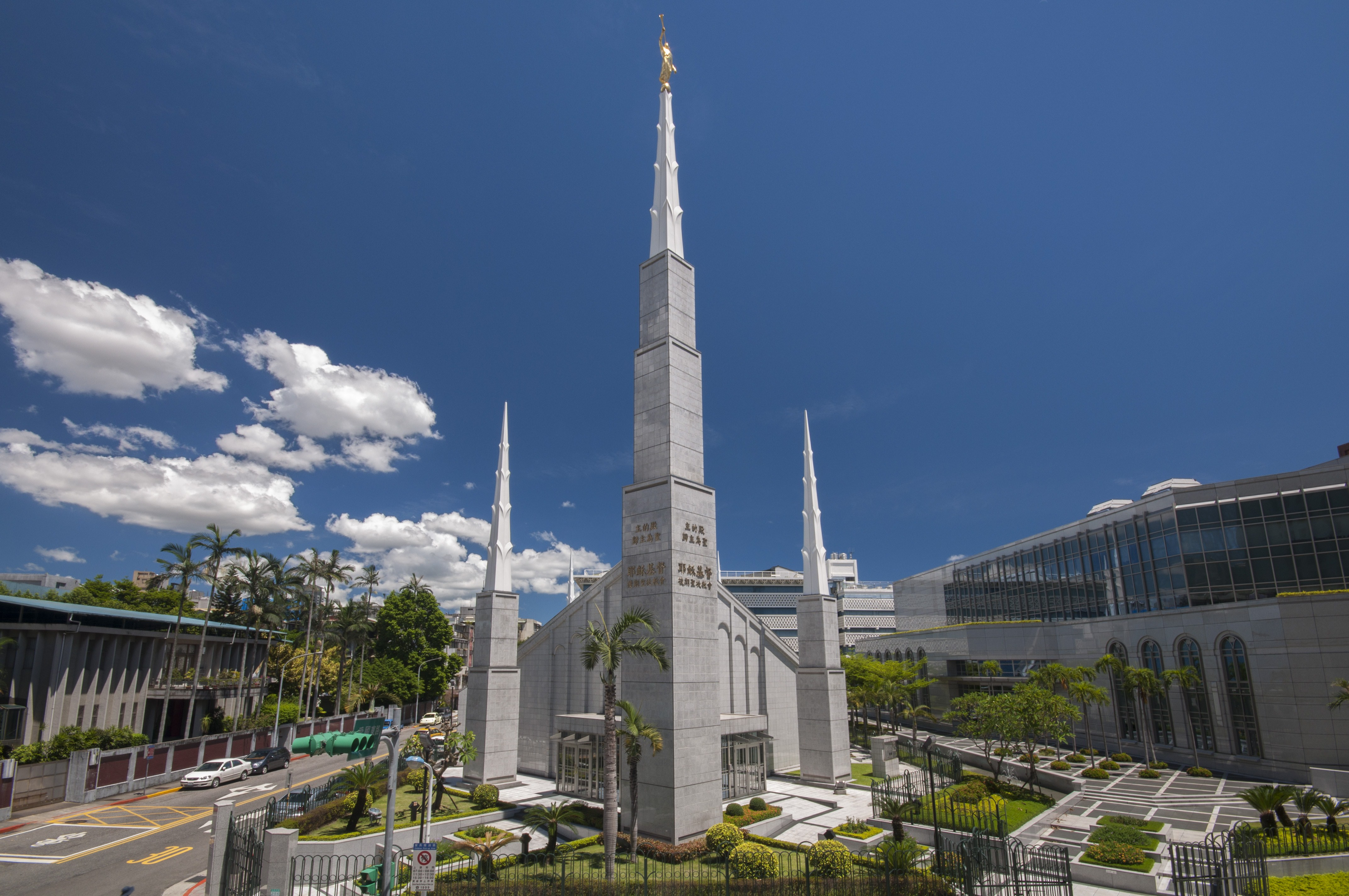 Taipei Taiwan Temple in new multipurpose Church Administration Building in Taipei in 2006. Courtesy of Chen Ren Jie (Jay).
Taipei Taiwan Temple in new multipurpose Church Administration Building in Taipei in 2006. Courtesy of Chen Ren Jie (Jay).
There were also other building projects, including five other stake centers and buildings constructed during this period. Each of these buildings followed similar plans. These included new Church buildings in Taoyuan, Taichung, Chung Hsing, Tainan, Kaohsiung, and Hualien, as well as additional Church buildings in other locations throughout Taiwan. Institute facilities were included in the Taichung and Kaohsiung stake centers. On 11–12 September 2004, the new Kaohsiung stake center held its open house activities, which included three-on-three basketball games. The following month, on 9 October, the new Taichung stake center and genealogy center held its open house and dedication. A few weeks later, on 27 November 2004, the new Chung Hsing stake center held its open house activities.[19]
More than 800 people, including politicians, investigators, and others, visited the Chung Hsing Taiwan Stake Center late last year during an open house that allowed members of the Chung Hsing stake to share their faith with those in the community.
The open house, which members of the stake spent many hours organizing and preparing, consisted of a tour that led visitors to 10 areas in the building. In each area a different topic of the gospel, Church services, or life as a Latter-day Saint was discussed. . . .
The Chang Hua County Commissioner toured the building and remarked how impressed he was with the intelligence and eloquent social skills among the youth in the stake. Before leaving, he posed for a picture with the Primary children in front of the building.
Members of the stake said they felt blessed in their effort to build goodwill for the Church in the community.[20]
Hong Wei-Chin (洪偉欽), who was the first stake president for the Hsinchu Taiwan Stake, recalled his experience when assigned to dedicate two chapels in his stake during the mid-2000s. The first was the chapel in Chutong, followed by the new Hsinchu stake center built on half of the lot purchased in Chupei. After receiving a letter from the Asia Area Presidency assigning him to dedicate the new buildings and coordinate the date for the open house and dedication with the Taiwan Service Center, the Hsinchu Taiwan Stake held an open house and dedication of their new stake center on the same day, where many members of the Church and from the community were in attendance. President Hong noted he was not given much instruction about the dedication except to keep it simple, use his priesthood authority to dedicate the building, and send a report to the Taiwan Service Center afterwards. His was a unique opportunity and a blessing.[21]
These new buildings built in the 2000s were a great blessing for the Saints, providing them with stake and ward offices, large chapels for sacrament meetings, and cultural halls with indoor basketball courts. Additional construction projects followed to provide new facilities for the members of the Church in Taiwan to gather and worship together. Chang Jui-Sheng (張瑞昇), the first stake president for the North Taichung Taiwan Stake, also had similar experiences when he was assigned to dedicate two chapels in his stake, including the rebuilt chapel in Fengyuan in 2007 and the Shalu chapel in 2008.[22]
Fiftieth Anniversary Jubilee Celebration
In 2006, the members of the Church in Taiwan celebrated fifty years of missionary work in Taiwan. Elders Yang Tsung-Ting (Jared) and Ho Yu-Chen (Philip), both Area Seventies, along with Elder and Sister Miner, a missionary couple, served as members of the Taiwan Jubilee executive committee, organizing the various events for this celebration. The Jubilee Celebration included mission reunions and firesides, a bicycle relay around the island, an island-wide youth conference, and cultural events.[23] There were special firesides on the history of the Church in Taiwan, dedication events, and a fiftieth anniversary DVD.[24] This DVD included the history of the Church in Taiwan over the last fifty years, including pictures, photos, videos, and other materials or documents.[25]
In speaking about the fifty-year commemoration events, Elder Ho Yu-Chen (Philip), an Area Seventy, read Leviticus 25:10 and quoted, “And ye shall hallow the fiftieth year, and proclaim liberty throughout all the land unto all the inhabitants thereof: it shall be a jubilee unto you.”[26] According to the Ensign, the Church in Taiwan grew drastically during the first fifty years: “Those 50 years are also marked by the creation of three missions, construction of a temple, and membership approaching 50,000. From those first 4 elders in 1956 to almost 400 elders in 2006, missionaries and members are celebrating half a century of the gospel in Taiwan.”[27]
Fireside and Mission Reunion
The Taiwan Jubilee officially began in May with firesides in Kaohsiung, Taichung, and Taipei. Former missionaries, mission presidents, and temple presidents, along with their spouses, joined local members at these firesides. It was a wonderful opportunity to reconnect with old friends.[28] The fireside in Taipei was held on 13 May 2006 at the Chin Hua Street chapel, welcoming the three stakes in Taipei and the one in Taoyuan. They sang “Called to Serve” and heard talks from many of the early pioneers of the Church in Taiwan. Sister Chen Lin Shu-Liang (陳林淑良), the first local Chinese Relief Society president, spoke, noting that she was speaking on the fiftieth anniversary of the Church in Taiwan as well as the fiftieth anniversary of her baptism, both of which occurred in 1956. Other members looked to Sister Chen as a great example of enduring to the end. An orchestra composed of youth from central and northern Taiwan played “Faith in Every Footstep.”[29] A similar fireside was held the following week in Taichung.[30]
A commemoration was held at the Grand Hotel in Taipei on 3 June 2006 to commemorate the dedication of Taiwan for the preaching of the gospel by Elder Mark E. Petersen on 1 June 1959.[31] Elder Daryl H. Garn, then the Asia Area President, presided over this meeting, which was attended by various leaders and members, including Elders Weldon J. Kitchen and Melvin C. Fish. These men were two of the first four missionaries to come to Taiwan in 1956. Another notable attendee was W. Brent Hardy, the mission president for the Southern Far East Mission from 1968 to 1969 and for the Hong Kong–Taiwan Mission from 1969 to 1971.[32] A morning and afternoon session were held at the Grand Hotel in Taipei, which included the reading of the dedicatory prayer given by Elder Mark E. Petersen back in 1959. The morning session was held at 9:30 a.m. in the International Conference Room on the tenth floor. The dedicatory prayer was read in Chinese by Teng Shuei-Tyan (曾水田), then stake president of the Taipei Taiwan Central Stake, and in English by Antony D. Perkins, then mission president for the Taiwan Taipei Mission. The afternoon session was held at 1:30 p.m. at the International Reception Hall on the first floor. The dedicatory prayer was read in Chinese by Chou Wen-Tsung (周文宗), then president of the Kaohsiung Taiwan Mission, and in English by Scott R. Watterson, then president of the Taichung Taiwan Mission.[33]
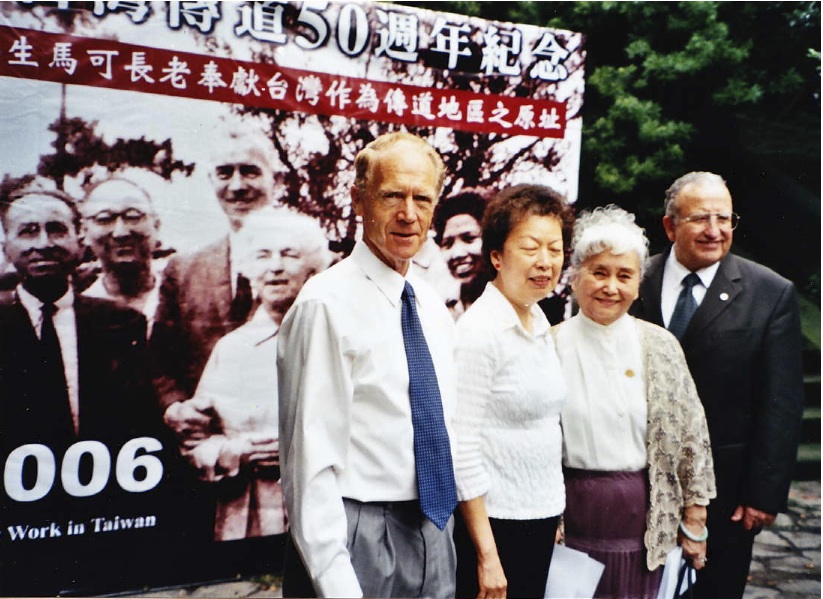 Weldon Kitchen, Melvin Fish, and early converts at the fiftieth anniversary celebrations in 2006. Courtesy of Weldon Kitchen.
Weldon Kitchen, Melvin Fish, and early converts at the fiftieth anniversary celebrations in 2006. Courtesy of Weldon Kitchen.
Bicycle Relay
The Taiwan Jubilee logo featured two missionaries riding their bikes. Elder Ho Yu-Chen explained, “Two missionaries riding bikes have been the symbol of our Church in Taiwan.”[34] As part of the celebration and commemoration of the fifty years of the Church in Taiwan, a bicycle relay was organized around the island. Both members and missionaries participated in the Taiwan Legacy Bike Relay, biking from Taitung or Hengchun all the way to Taipei.[35]
This bicycle relay around the island went from 31 July to 7 August 2006. It included six- to seven-hour rides of about fifty miles (eighty kilometers) each day. Team leaders for each segment of the relay carried flags. Members and missionaries wore helmets and missionary attire as they participated in this bicycle relay with support vehicles following them, which generated much media attention. The Taiwan Legacy Bike Relay concluded with the last bicycle group arriving at the Taipei Taiwan Temple.[36] Huang Yong-Da (黃永達), from Kaohsiung, remembers that members and missionaries, both young and old, participated in the bicycle relay together. The relay was featured in several news outlets.[37] Chang Jui-Sheng (張瑞昇) from Taichung participated in the bicycle relay with his family and said he would always remember “the image of the group of missionaries and families biking together down the streets of Taiwan, a symbol of the Church in Taiwan.”[38]
Cultural Celebration
On 5 August 2006, a cultural celebration was held in Taiwan that included various performances “featuring dancing, and a 50-member orchestra.”[39] In addition to the orchestra, there was a 130-member youth choir and 260-member adult choir. The local Church news report noted that the cultural arts performance was held at the Changhua Athletic Center, integrating both the Chinese culture and the history of missionary work in Taiwan. The two-hour performance included music, dancing, drama, and multimedia presentations. The Hsinchu, Taichung, and Chung Hsing stakes helped to plan the event. The stake presidency and bishoprics from the three stakes performed the lion and dragon dances, and youth shared their Kung-Fu skills during the Chinese cultural performances.[40]
According to Chang Jui-Sheng (張瑞昇), who helped host the cultural celebration, over one thousand youth from all over Taiwan gathered and performed for the large audience, which included several past and present Church leaders and missionaries. He also noted that many of the youth committed to and later went on to serve as full-time missionaries and that the fiftieth anniversary celebration allowed more people to learn about the Church throughout Taiwan.[41] Chen Ting Hui (陳定輝), the first stake president of the Chung Hsing Taiwan Stake, worked with Elder Ho and others for the fiftieth anniversary celebration and reported that there were about six thousand people from all over the island who attended the cultural event.[42]
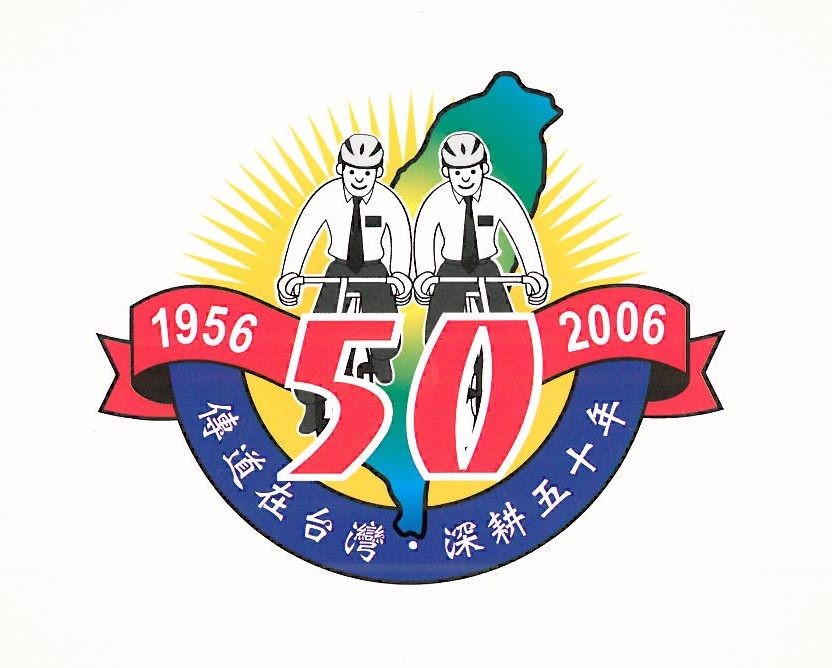 Taiwan fiftieth-anniversary banner in 2006. Courtesy of Phil and Brenda Frandsen.
Taiwan fiftieth-anniversary banner in 2006. Courtesy of Phil and Brenda Frandsen.
Island-wide Youth Conference
On 24–26 August 2006, youth from all over the island gathered in central Taiwan for an island-wide youth conference. The theme of the conference was “Arise and Shine Forth,” taken from Doctrine and Covenants 115:5, which reads, “Verily I say unto you all: Arise and shine forth, that thy light may be a standard for the nations.” A music CD was commissioned and produced for this island-wide youth conference to encourage the youth to take the gospel to their own people. Stacy Yu and her family helped to coordinate this project. They invited several LDS artists, who donated their work for this project. This CD was also entitled Arise and Shine Forth, reflecting the theme for the youth conference, and the inscription on the CD stated, “It is hoped that this collection of inspirational music will lead the listener to draw faith from the scriptures, meditate on testimony and prayer, and find joy in sharing the truth.”[43] Music was selected to help inspire the youth and prepare them to fulfill their role to help preach the gospel to their own people in Taiwan.[44]
Besides the production of the CD, there were additional preparations for the island-wide youth conference. Efforts were made by each ward and branch in the island to invite all the youth of the Church. One hundred handcarts were made over a period of three months, following the pattern used by other youth trek handcarts in the United States. Every detail was considered to ensure they resembled the handcarts the pioneers used.[45] In addition, individuals with experience running Especially for Youth (EFY) programs in the United States were enlisted to help train about 160 local counselors and leaders that coordinated the three-day conference. These EFY counselors provided a two-day training to help local leaders and others assigned to serve as counselors for this event.[46]
A tremendous effort was put forth to invite all the youth to join and participate in this once-in-a-lifetime experience that focused on providing them with a variety of spiritual experiences, opportunities to develop friendships, and the chance to participate in and experience some of the physical challenges overcome by the handcart pioneers. The following message was sent to the youth inviting them to the island-wide youth conference:[47]
As one of the major events for the Jubilee Celebration in Taiwan, the Island-wide Youth Conference in August of 2006 will gather together over 1,000 LDS youth for the first time in 30 years to arise and shine forth. A three-day conference will bring these young men and young women through different spiritual, fellowshipping, as well as physical experiences. A first-time, outside of North America handcart trail will be held during the conference. One hundred handcarts have been made and tested in the past three months. EFY experts from the United States had trained 160 local counselors and leaders. They, in turn, will bring 1,000 [youth] though the same experience they had during a two-day training by EFY experts.[48]
Other activities during the youth conference included a fireside, missionary experiences, various workshops, and a testimony meeting.[49] Elder Ho Yu-Chen noted the following about this special youth conference: “We focus on [the youth] because that’s the future of the Church.”[50] Chen Ting Hui (陳定輝), the stake president of the Chung Hsing Taiwan Stake, said that with the help of Scott R. Watterson, then the mission president of the Taichung Taiwan Mission, they built one hundred pioneer handcarts for the one thousand youth attending the island-wide youth conference.[51]
Huang Jing-Song (黃景崧), a young man at the time, said that he loved the island-wide youth conference, where he pulled handcarts for the first time and learned about the pioneers and their challenges. He was also surprised to see so many youth pulling handcarts, helping him to strengthen his testimony and prepare him for his mission.[52] Chang Jui-Shen (張瑞昇) and his wife served as adult leaders—called the “ma and pa”—responsible for a trek family and recalled how pulling handcarts with the youth helped them to share in the experience of early Mormon pioneers.[53]
Seminary, coupled with the island-wide youth conference held in 2006, had a tremendous impact on the youths’ desire to serve missions. Wang Jung Ling (王榕翎) understood that when the youth attended the island-wide youth conference, they gathered and pulled handcarts in Taiwan for the first time and learned leadership skills as they guided and directed various activities. President Scott Watterson, then the mission president for the Taichung Taiwan Mission, asked the one thousand youth attending to stand up if they were planning to serve a mission, and all one thousand youth stood up.[54]
Chang Chih Hsun (張志勳), the stake president of the East Taichung Taiwan Stake, noted that after the island-wide youth conference, many more went on missions.[55] Similarly, Tsai Feng-Cheng (蔡豐丞), the stake president for the Hsinchu Taiwan Stake, also said that after the island-wide youth conference in 2006, there was an increased number of local missionaries who were excited to serve missions. He also discussed the effects of opening the early-morning seminary program in Taiwan, which taught the youth to rise early, learn how to plan, prepare to serve missions, and help the Church grow.[56] Lee Shih-Jung (Robert) (李世榮) and Lee Tsai Shu-Min (Bridget) (李蔡淑敏) noted that besides the youth conference, daily consistent experience with the word of God such as that experienced in daily seminary and daily scripture study were necessary to encourage and prepare the youth for missions.[57]
Fiftieth Anniversary of the Dedication, Followed by the World Games
After the Taiwan Jubilee in 2006, the Church celebrated the fiftieth anniversary of the dedication of Taiwan in 2009. That June, a group of Church members and full-time missionaries gathered by the hillside near the Grand Hotel in Taipei, where fifty years earlier, Elder Mark E. Petersen of the Quorum of the Twelve Apostles dedicated Taiwan for the preaching of the gospel on 1 June 1959. The Saints congregated to remember and commemorate this important event in the history of the Church in Taiwan.[58]
Fifty years since the dedication, the Church had become more prominent in Taiwan, as illustrated by the government’s invitation to have LDS missionaries help with a world event in Taiwan. In 2009, the Church was recognized by the government for assisting with the 2009 World Games in Kaohsiung. Held every four years, the two-week event attracted 4,600 athletes and coaches from 103 countries and tens of thousands of international visitors to Kaohsiung, Taiwan.[59]
At the request of the local city government, LDS missionaries held weekly English classes during the summer for government officials and officers of the Kaohsiung City Police Department. In addition, since the LDS missionaries were bilingual in both English and Chinese, the Kaohsiung office of the American Institute in Taiwan (AIT) also invited the missionaries to provide hosting and translation services for the hundreds of athletes, coaches, and officials who visited their exhibition or attended the gala reception. Chris Castro, the branch chief of AIT’s Kaohsiung office declared, “Your missionaries represent what is best about young people.”[60]
Updated Chinese Scriptures and Key Church Terminology
Revised Chinese Union Version of the Bible
Only three LDS editions of the Bible have been published by the Church. First, the English LDS edition of the King James Bible, which was released in 1979 under the direction of President Spencer W. Kimball, “to assist in improving doctrinal scholarship throughout the Church.”[61] A newer English edition was released in 2013. The other two editions included the Spanish LDS edition of the Reina-Valera Bible, released in 2009, and the Portuguese LDS edition of the Almeida Bible in 2015, which served similar purposes as the English LDS edition of the Bible.[62] No other LDS editions of the Bible have been produced by the LDS Church.[63]
The general practice of approving a non-LDS edition of the Bible for the various languages throughout the world has been applied to the Chinese Bible as well. The use of the same edition of the scriptures served to help unify members of the Church. Once a non-LDS edition of the Bible is selected and approved by the Church, the approved edition is the one sold at LDS Distribution Centers around the world. Handbook 2 explains, “The standard works of the Church are the Holy Bible, the Book of Mormon, the Doctrine and Covenants, and the Pearl of Great Price. In many languages, the Church has approved one edition of the Bible to be used in Church meetings and classes. Likewise, the latest authorized edition of the other three books of Latter-day Saint scriptures should be used.”[64]
For Chinese Latter-day Saints, the Church has approved the 1919 Chinese Union Version and the updated Revised Chinese Union Version published by Protestant Christians in 2010, standardizing the Bible used in Chinese LDS congregations throughout the world. As noted in a previous chapter, early missionaries to Taiwan used the Bible before latter-day scriptures became available. Although early drafts and partial translations of the Bible were started by various individuals and groups in the 1800s, the Protestant Chinese Union Version published in 1919 became the predominant and most widely used Chinese translation of the Bible. The Chinese Union Version helped to standardize gospel terminology and Christian vernacular in Chinese.[65]
The Chinese Union Version had been used by more than 90 percent of Chinese Christians for over ninety years prior to the release of the Revised Chinese Union Version. The revised Chinese translation of the New Testament was produced in 2006, followed by the entire Bible on 27 September 2010. This revision took nearly thirty years with Dr. Lien-Hwa Chow and Dr. Wei-Ren Luo as the chief editors, as well as the help of more than thirty Bible scholars around the world. The revised version sought to make difficult sentences easier to understand, while still being true to the original text. A minimalistic approach sought to be loyal to the original text, resulting in minor changes to 15–20 percent of the original version. The Hong Kong Bible Society states:[66] “The Bible is a valuable book. . . . [We’re] confident that the revised edition would make everybody better understand the truth of the Bible. . . . [We] also hope this Bible can continue to bless Hong Kong and all the Chinese [people] around the world.”[67]
Chinese members of the LDS Church felt they benefitted greatly by having this version of the Chinese Bible. Brother Tsai Yu Lung (Nathan) (蔡鈺龍), then the supervisor of the Taipei Distribution Center in the early 2000s noted, “In accordance to the policy adopted by the Church, we sell one version of the Bible for members in Taiwan, Hong Kong, or elsewhere.”[68] Although the written Chinese is standardized (both the traditional and the simplified Chinese characters), there are some language differences between the various Chinese dialects spoken in Taiwan, Hong Kong, and mainland China. Nevertheless, having one version of the Chinese Bible helps to standardize and unify Chinese Latter-day Saints worldwide.
2007 Translation of the Chinese LDS Scriptures
In 2007, the Church published a new edition of the Chinese LDS scriptures. Just as producing the original translations proved challenging, there were trials to overcome in preparation for the 2007 translation of the Chinese scriptures. Larry Browning noted the following challenges that resulted in the delay of the revised Chinese scriptures:
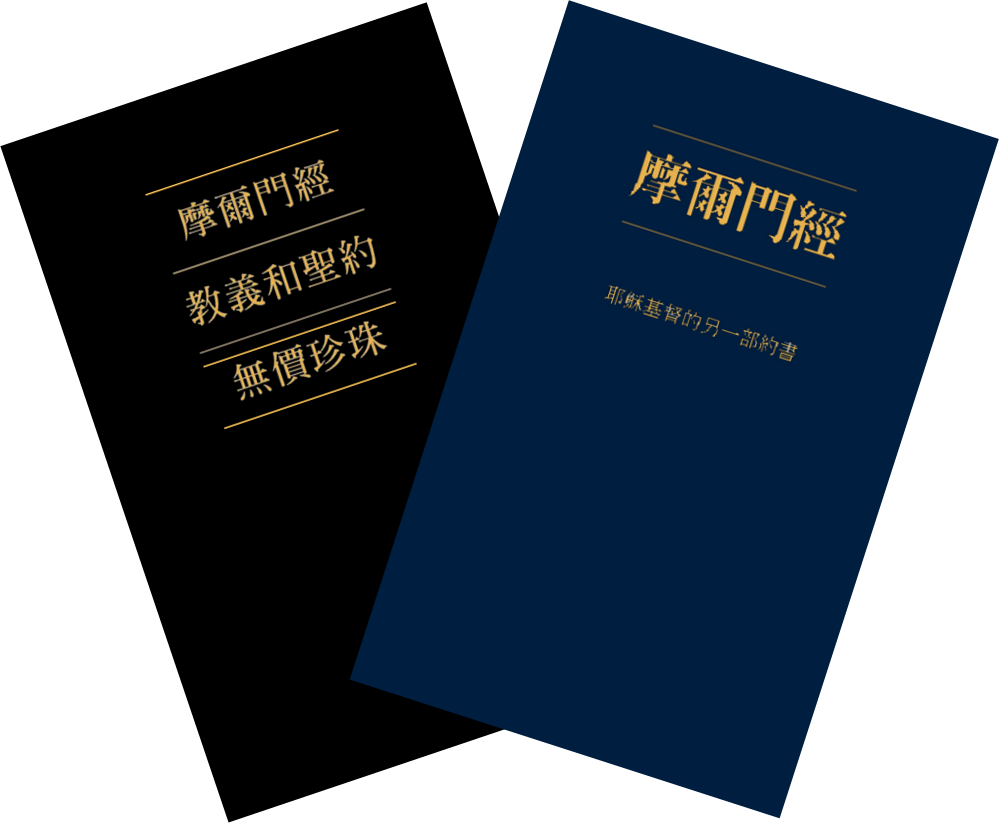 In 2007, an updated Chinese translation of the Book of Mormon and triple combination of the LDS scriptures was published. Courtesy of Chou Po Nien (Felipe).
In 2007, an updated Chinese translation of the Book of Mormon and triple combination of the LDS scriptures was published. Courtesy of Chou Po Nien (Felipe).
The management of translation change[0] back and forth with Salt Lake wanting to be in charge as did the missions (two by then, Hong Kong and Taiwan, then two and three in Taiwan).
It was decided to include the extensive notes and other aids that had come out earlier with the English. This was a huge task.[69]
Church policies and practices pertaining to scripture translations into the various languages of the world have been refined and streamlined since Hu’s translation of the Chinese Book of Mormon in 1965. This updated process has helped reduce the cultural differences and misunderstandings that hindered the work of early translators.[70] Following established policies, a recommendation by the Asia Area Presidency was sent to the offices of the First Presidency and the Quorum of the Twelve for approval for a revised translation of the Chinese scriptures.[71]
Various translation aids and the use of computers and computer-assisted translation software developed since the 1960s helped to facilitate the translation process.[72] In addition, a committee composed of many faithful, worthy, and qualified members—rather than a single individual—completed the translation effort. Their translation, reviewed by local leaders matured in the gospel, was further coordinated with the Church’s Translation Service Department. The translation was also reviewed by members of the First Presidency and the Quorum of the Twelve Apostles as needed.[73]
The 1981 English LDS scriptures served as an important reference for the updated Chinese translation of the Book of Mormon. Brother Chung Kuo Chiang (Joseph) (仲國強) was assigned to begin a revised Chinese translation in September 1980. Although an initial translation was completed by 1986, there were many changes over the next twenty years.[74] Sister Yang Peng Mei-Jyan (楊彭美堅) recalled being part of a ten-year run of the scripture translation project supervised by Chung. They used an English committee of five to six people responsible for translating the scriptures from English to Chinese, as well as a priesthood or Chinese committee to review the Chinese translation. Then around 1999, Brother Chung also began work on the retranslation of the Doctrine and Covenants and Pearl of Great Price.[75]
One issue resulted from transferring the translation to the new computer system in the 1990s and verifying the translation. After the scripture team completed the new translation so it would be ready to print in 2000, the nonscripture team was invited to do a review; but they found many errors with the translation that was sent to layout and typesetting. They discovered about one hundred errors per page, mostly from “control codes” that had not been cleaned out after the transfer to the new computers, along with pagination issues. Overall, the problem was not so much with the translation but with formatting errors. Brother Tsai Fu-An (Steve) (蔡福安) noted that although the Church was about to print the updated translation in 2000 and everything including the layout was ready to print, the numerous glaring formatting errors caused the Church to hold off printing.[76]
In addition, the work on the Guide to the Scriptures led to additional delays. Due to health problems, Chung Kuo Chiang (Joseph) (仲國強) asked Tsai Lin (Cassandra) (蔡琳) to help with this translation project. A vocabulary list of over two thousand words came from Salt Lake, and a consistency check of the Chinese translation was necessary. Brother Tsai Fu-An (Steve) (蔡福安), who had a significant background in computers, was assigned to help with the consistency checks and manage the computer database. Elders Chia Chu-Jen (賈居仁) and Ho Yu-Chen (Philip) (何於振), both Area Seventies, reviewed the changes from 2000 to 2007. Others such as Hsieh (or Xie) Fan (謝凡), Lin Chun Shie (林春水), and Pan Lie Na (潘蓮娜) also helped with the scripture translation project. The changes and updates resulted in about fifty thousand recorded changes, including many format changes.[77]
At last, the revised Chinese translation of the triple combination was published in 2007. As with all newly revised translations of the scriptures, the Church encouraged its members to use the most recent edition of the scriptures.[78] The new Chinese triple combination, released in 2007, included “additional study aids, like footnotes throughout, maps, a topical guide and pictures . . . An additional character was also added to the name of the book.”[79] A significant aspect of the 2007 translation was that it unified the simplified and traditional characters found in the Chinese translation of the scriptures. Moreover, the translation of the Book of Mormon title changed from 摩門經 to 摩爾門經, or from “Mó mén jīng” to “Mó ěr mén jīng.” This simple change was important to minimize misunderstanding and misperceptions brought about by anti-Mormon groups. The former was a transliteration of the word Mormon, which resulted in strong negative connotations and reference by anti-Mormon groups who suggested that it sounded similar to other Chinese characters used for “the devil’s gate.” The latter and current Chinese translation indicates that Mormon is a name.[80]
The attached materials from the First Presidency announcing the 2007 Chinese edition emphasized the importance of using the new edition rather than previous editions. The First Presidency stated the following:
This new edition of the Chinese (Traditional Characters) triple combination is based on the 1981 English edition. . . . Elder Boyd K. Packer said in the October 1982 general conference:
“With the passing of years, these scriptures will produce successive generations of faithful Christians who know the Lord Jesus Christ and are disposed to obey His will.”
The study aids in this new edition of the triple combination and its inspired translation will help all readers become better acquainted with the Lord. To fully enjoy the blessings of this new edition, members should obtain their own copy and study the scriptures daily, individually and as a family.[81]
A digital version of the Chinese triple combination of the scriptures in traditional characters became available online in December 2009. The accompanying announcement from the Church said that as members diligently “learn and teach from the scriptures, their testimonies will grow, their knowledge will increase.”[82] The Church News reported, “Church members throughout Asia whose native language is Chinese have received the news of the availability of the Chinese language triple combination of the scriptures online with great excitement and anticipation. . . . This historic step forward is particularly important in Asia where the population of Internet users is greater than any other region of the world.”[83]
Elder Wong Chi Hong (Sam) (黃志康), a member of the Quorum of the Seventy, said, “Chinese members of the Church in Hong Kong, Taiwan, Singapore and many other countries will greatly appreciate having these sacred scriptures available to them on-line, and they will increasingly use them to learn and grow spiritually.”[84] Tsai Fu-An (Steve) (蔡福安) was serving as the Taoyuan Stake president and hoped that members would “increasingly appreciate being able to access the scriptures found in the triple combination via the Internet.”[85] Sister Hsu Hwei-Chi (許妹姐) of the Taipei Second Ward in Taiwan said, “Our loving Heavenly Father . . . sent missionaries who shared with me the teachings in the Book of Mormon. This latter-day scripture was like dawning light in my dimming life, bringing me precious peace and comfort I needed.”[86]
Key Church Terminology Updated
Shortly after the release of the 2010 Handbook of Instructions in Chinese, Church leaders in Taiwan received a letter on 16 September 2010 from the First Presidency announcing changes to key Chinese Church terminology:[87]
Key Terminology Changes in Chinese
After much consideration, we have approved the revised translation of key Church terms in Chinese. These changes bring greater consistency to Church terminology among Chinese speakers in different regions and greater conformity with revealed doctrine.
An explanation and table of terminology changes have been provided to your bishop or branch president. It will be printed in the local news section of the Chinese Liahona in December 2010.
Chinese-speaking members will begin to hear and read these new terms in upcoming Church broadcasts and publications, including the scriptures.
We invite all Chinese-speaking members to begin using these revised terms.
Sincerely yours,
Thomas S. Monson
Henry B. Eyring
Dieter F. Uchtdorf
The First Presidency[88]
This letter was to be read in sacrament meetings throughout Taiwan. Accompanying the letter were additional pages with explanations regarding key terminology changes in Chinese, such as new titles for two auxiliary organizations (Relief Society and primary), new titles for four callings (General Authority, clerk, president of a young women class, and counselors), and a new term for persons who belong to the Church (member). They also clarified terms for family history work (family history and genealogy). These changes are shown below.[89]
Key Term (in English) | Key Term (previous Chinese translation) | Key Term (new Chinese translation) |
| Clerk | 書記 (shūjì) | 文書 (wénshū) |
| Counselor | 副會長 (fùhuìzhǎng) 副主教 (fùzhǔjiào) | 諮理 (zīlǐ) |
| Family History | 家譜 (jiāpǔ) 家庭歷史 (jiātíng lìshǐ ) | 家譜 (jiāpǔ) |
Genealogy (for curriculum, not scriptures) | 家譜 (jiāpǔ) (在課程和手冊, 不包括經文) | 族譜 (zúpǔ) (在課程和手冊, 不包括經文) |
| General Authority | 總會當局人員 (zǒnghuì dāngjú rényuán) | 總會持有權柄人員 (zǒnghuì chíyǒu quánbǐng rényuán) |
| Member | 教友 (jiàoyǒu) | 成員 (chéngyuán) |
President (of a Young Women class) | 班長 (bānzhǎng) (女青年班級) | 會長 (huìzhǎng) (女青年班級) |
| Primary | 兒童會 (értónghuì) | 初級會 (chūjíhuì) |
| Release | 卸免 (xièmiǎn) | 卸任 (xièrèn) |
| Relief Society | 婦女會 (fùnǚhuì) | 慈助會 (cízhùhuì) |
Some changes were made to align with scriptures or prophetic declarations, and others sought translation more commonly used and more easily understood by investigators and new converts from different regions.[90] As with any new translation or changes, members struggled at first to get used to the new changes in key terminology and Church vocabulary as they diligently sought to follow direction from Church leaders.[91] Sister Wang Lin Ping-Yuan (王林平苑) believes that the updated Chinese terminology and the 2007 Chinese Latter-day scriptures are blessings to help the Saints better understand the word of God. Although the reasons for the changes may not be self-evident at first and may require time to adjust, when looking back, one can see how these inspired and important changes have affected and blessed the Church and its members.[92]
One Hundredth LDS Congregation, Followed by Recognition by Taiwan President
In May 2008, the Mingchien Branch was created in central Taiwan, the one hundredth congregation of The Church of Jesus Christ of Latter-day Saints in Taiwan. Church membership was approaching fifty thousand by this time.[93] A couple of months later, on 16 July 2008, the president of Taiwan met with a delegation of the Church led by Elder Chung Kuo Chiang (仲國強), then an Area Seventy from Taipei. The Taipei Times reported the following in regards to this meeting:
President Ma Ying-jeou (馬英九) in July 2008, lauded the contributions of the Church of Jesus Christ of Latter-day Saints in Taiwan, saying their missionaries helped spread positive values and spirit. Ma made the remarks while meeting a delegation headed by Chung Kuo Chiang (仲國強), leader of Taiwan’s Mormon Church. Over the past decades, Ma said, the Church has taken root in Taiwan because of the way young Mormons spread their faith.
The sight of two young men sporting crew-cuts and wearing white shirts with black ties riding bicycles has become an important part of the urban landscape, he said. “Their clean image elicits good feelings,” Ma said, adding that he admires the Mormons’ pioneering efforts to “promote energy conservation by using bicycles as their main mode of transport.” Noting that his administration has made energy conservation and carbon reduction its major policy goals, Ma said he hoped Mormons would uphold their tradition. Ma also said he was moved by Church founder Joseph Smith’s efforts to spread his faith despite opposition and persecution in the early days of the Church’s development.[94]
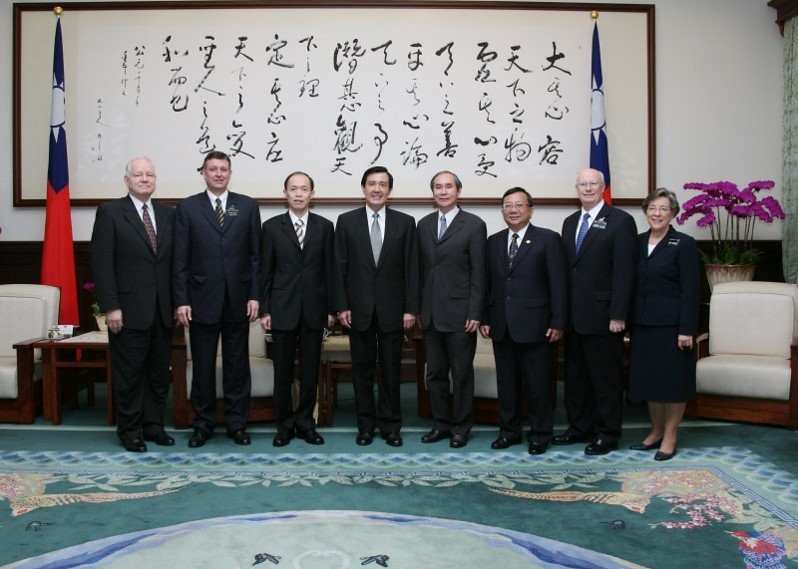 Taiwan president Ma Ying-Jeou meets with Church delegation headed by Elder Chung Kuo Chiang in July 2008. Courtesy of Phil and Brenda Frandsen.
Taiwan president Ma Ying-Jeou meets with Church delegation headed by Elder Chung Kuo Chiang in July 2008. Courtesy of Phil and Brenda Frandsen.
Conclusion
The 2000s would be marked by the expansion and construction of several new buildings, including the new multipurpose Church Administration Building in Taipei dedicated by President Hinckley. There were also additional Church buildings built during this time period. These changes were indeed a blessing to the Saints in Taiwan and prepared the stakes to further expand and grow throughout the island. Another important event was the fiftieth anniversary celebration of the Church in Taiwan marked by various events, including firesides, mission reunions, a bicycle relay, a cultural celebration, and an island-wide youth conference. This jubilee celebration served to remember the early pioneers of the Church in Taiwan while also strengthening the faith of the rising generation as they prepared to carry on with the work of salvation.
Other events that furthered the cause of Zion in Taiwan included the release of the 2007 edition of the Chinese LDS scriptures to increase knowledge and understanding of the gospel among the Saints in Taiwan, followed by updates to key Church terminology for the Chinese Saints. An additional milestone came with the organization of the one hundredth LDS congregation in Taiwan, followed by recognition of the Church by the Taiwan president.
Notes
[1] Chien Chie-Fang, “Family Value Award,” Liahona (Chinese), February 2005, n-10–13.
[2] Liao Ji Shuen, interview by Chou Po Nien (Felipe), 14 November 2015, Taichung, Taiwan.
[3] Nicole Seymour, “News of the Church: Members Hear General Conference, announcements in 80 Languages,” Ensign, November 2005, 126.
[4] Chou Po Nien (Felipe), personal history and journal entries, 2005.
[5] Liang Shih-An, interview by Chou Po Nien (Felipe), 20 November 2015, Taipei, Taiwan.
[6] Yang Shih-Ning, interview by Chou Po Nien (Felipe), 16 November 2015, Kaohsiung, Taiwan.
[7] Chung Yin-Chang (Ivan), interview by Chou Po Nien (Felipe), 21 November 2015, Taipei, Taiwan.
[8] Yang Shih-Ning, interview by Chou.
[9] “History of Chin Hua Street Chapel,” Liahona (Chinese), February 2003, n-9–15.
[10] “Zion’s Borders Continues to Expand,” Liahona (Chinese), June 2005, n-14–16.
[11] Wang Ling-Xing, interview by Chou Po Nien (Felipe), 20 November 2015, Taipei, Taiwan.
[12] “Using Mormon.org to Share the Gospel,” Liahona (Chinese), December 2005, n-5–7.
[13] “Taiwan,” 2013 Church Almanac, The Church of Jesus Christ of Latter-day Saints (Salt Lake City: Deseret News, 2012), 573–74.
[14] Wang Ling-Xing, interview by Chou.
[15] Greg Hill, “President Hinckley Travels to Taipei and Hong Kong: LDS Leader Dedicates New Church Buildings in Both of the Cities,” Deseret News, 3 August 2005.
[16] Chien Chie-Fang, “The Prophet Comes to Dedicate Taipei Administration Building,” Liahona (Chinese), December 2005, n-10.
[17] Tsai Feng-Cheng, interview by Chou Po Nien (Felipe), 21 November 2015, Taipei, Taiwan.
[18] “Taipei Taiwan Temple,” Wikipedia, 15 May 2013, http://
[19] Lee Pei Chun, He Chen Wei Fong, Yang Wang Hui Chuen, Huang Xin Ya, Lee Shih-Jung, and Chien Chie-Fang, “Zion’s Borders Continues to Expand,” Liahona (Chinese), June 2005, n-14–16.
[20] Chad Phares, “News of the Church: Taiwan Stake Open House Builds Community Relations,” Liahona, June 2005, n-7.
[21] Hong Wei-Chin, interview by Chou Po Nien (Felipe), 21 November 2015, Taipei, Taiwan.
[22] Chang Jui-Sheng, interview by Chou Po Nien (Felipe), 14 November 2015, Taichung, Taiwan.
[23] Jared Yang, Philip Ho, Elder and Sister Miner, Arise and Shine Forth album, Taipei, Taiwan, 17 August 2006.
[24] Chien Chie-Fang, “Introduction of 50th Anniversary Activities,” Liahona (Chinese), June 2006, n-15–16.
[25] “50th Years Celebration Activities of the Preaching of the Gospel in Taiwan,” Liahona (Chinese), March 2006, n-16.
[26] Brittany Karford, “News of the Church: Taiwan Jubilee, Saints Celebrate 50 Years,” Ensign, July 2006, 77.
[27] Karford, “News of the Church: Taiwan Jubilee, Saints Celebrate 50 Years,” 77.
[28] Karford, “News of the Church: Taiwan Jubilee, Saints Celebrate 50 Years,” 77.
[29] Liao Miao-Jun and Wang Hui-Chuan, “Mission Work’s 50th Anniversary Activities: Combined Report of the History Review Fireside,” Liahona (Chinese), August 2006, n-12–14; Chao Shi Xin-Jun and Lee Pei-Jun, “Mission Work’s 50th Anniversary Activities: Cultural Night Preparation Report,” Liahona (Chinese), August 2006, n-14–16.
[30] Liao Miao-Jun and Wang Hui-Chuan, “Mission Work’s 50th Anniversary Activities: Combined Report of the History Review Fireside,” n-12–14.
[31] Karford, “News of the Church: Taiwan Jubilee, Saints Celebrate 50 Years,” 77.
[32] Chien Chie-Fang, “Celebrating Taiwan Mission’s 50th Anniversary Activity: Memorial Meeting for the Taiwan Dedication for the Preaching of the Gospel,” Liahona (Chinese), September 2006, n-13–16.
[33] Chien Chie-Fang, “Celebrating Taiwan Mission’s 50th Anniversary Activity,” n-13–16.
[34] Karford, “News of the Church: Taiwan Jubilee,” 77.
[35] Karford, “News of the Church: Taiwan Jubilee,” 77.
[36] Karford, “News of the Church: Taiwan Jubilee,” 77.
[37] Huang Yong-Da, interview by Chou Po Nien (Felipe), 13 November 2015, Taichung, Taiwan.
[38] Chang Jui-Sheng, interview.
[39] Karford, “News of the Church,” 77.
[40] Chao Shi Xin-Jun and Lee Pei-Jun, “Mission Work’s 50th Anniversary Activities,” n-14–16.
[41] Chang Jui-Sheng, interview by Chou.
[42] Chen Ting Hui, interview by Chou Po Nien (Felipe), 14 November 2015, Taichung, Taiwan.
[43] Jared Yang, Philip Ho, Elder and Sister Miner, Arise and Shine Forth album, Taipei, Taiwan, 17 August 2006.
[44] A list of the tracks and artists is included: 1. “Forward with Faith” by Jon Schmidt, 2. “I’m Trying to Be Like Jesus” by Inside Out, 3. “We’re Fighting a War” by Roger Hoffman, 4. “Our Mothers Always Taught Us” by Kory Kunz, 5. “Armor of Love” by Roger Hoffman, 6. “I’ll Follow Him in Faith” by Janice Kapp Perry and Greg Hansen, 7. “Here Am I, Send Me” by Steven Kapp Perry, 8. “Letters of Love” by Roger Hoffman and Melanie Hoffman, 9. “Meditation” (Sweet Hour of Prayer) by W. B. Bradbury and Lex de Azevedo, 10. “Savior” by Melanie Hoffman and Roger Hoffman, 11. “Lead Me This Day” by Dean Kaelin, 12. “Jesus, Savior” by Clark Johnson, 13. “Good Day” by Jon Schimdt, 14. “‘Give,’ Said the Little Stream” by Inside Out, 15. “I Will Stand” by Christy Hinkson and vocals by Youth Choir, 16. “The Spirit of God” arranged by Michael R. Hicks and vocals by youth choir, 17. “We Thank Thee O God for a Prophet” by Chinese Hearts, 18. “Give Them a Vision” by Mike Bearden and vocals by Voice Male.
[45] Jared Yang, Philip Ho, and Elder and Sister Miner, Arise and Shine Forth album, Taipei, Taiwan, 17 August 2006.
[46] Yang, Ho, and Elder and Sister Miner, Arise and Shine Forth album.
[47] Yang, Ho, and Elder and Sister Miner, Arise and Shine Forth album.
[48] Yang, Ho, and Elder and Sister Miner, Arise and Shine Forth album.
[49] Chien Chie-Fang, “Introduction of 50th Anniversary Activities,” Liahona (Chinese), June 2006, n-15–16.
[50] Karford, “News of the Church: Taiwan Jubilee,” 77.
[51] Chen Ting Hui, interview by Chou.
[52] Huang Jing-Song, interview by Chou Po Nien (Felipe), 13 November 2015, Taichung, Taiwan.
[53] Chang Jui-Sheng, interview by Chou.
[54] Wang Jung Ling, interview by Chou Po Nien (Felipe), 22 November 2015, Taipei, Taiwan.
[55] Chang Chih Hsun, interviewed by Chou Po Nien (Felipe), 14 November 2015, Taichung, Taiwan.
[56] Tsai Feng-Cheng, interview by Chou.
[57] Lee Shih-Jung (Robert), interview by Chou Po Nien (Felipe), 16 November 2015, Kaohsiung, Taiwan; Lee Tsai Shu-Min (Bridget), interview by Chou Po Nien (Felipe), 16 November 2015, Kaohsiung, Taiwan.
[58] James Phillips and Judith Phillips, “Celebrating 50 Years of the Gospel in Taiwan—LDS Church News,” Deseret News, 28 June 2009.
[59] “Mormon Missionaries Provide Language, Hosting Assistance at World Games,” Newsroom, 7 August 2009.
[60] “Mormon Missionaries Provide Language, Hosting Assistance at World Games,” Newsroom, 7 August 2009.
[61] A version of this section appears in print in Chou Po Nien (Felipe), Petra Chou, and Tyler Thorstead, “The Chinese Scriptures,” Mormon Historical Studies 17, nos. 1–2 (Spring/
[62] Heather Whittle, “News of the Church: Church Publishes LDS Edition of the Holy Bible in Spanish,” Liahona, September 2009, https://
[63] The general policy of the Church is that it “does not translate the Holy Bible into other languages.” Instead, the Church seeks to find in a given language “the most doctrinally accurate translation,” which is then “submitted to the Priesthood Executive Council to approve or conditionally approve for the Saints to read and study in their own language.” Grant Underwood, ed., Pioneers in the Pacific: Memory, History, and Cultural Identity among the Latter-day Saints (Provo, UT: Religious Studies Center, 2005), 133–34.
[64] “Scriptures,” Handbook 2: Administering the Church, (Salt Lake City: The Church of Jesus Christ of Latter-day Saints, 2010), 17.1.1.
[65] Jost O. Zetzsche, “The Work of Lifetimes: Why the Union Version Took Nearly Three Decades to Complete,” in The Bible in Modern China: The Literary and Intellectual Impact (Sankt Augustin, Germany: Institut Monumenta Serica, 1999).
[66] Katie Wong, “Revised Chinese Union Version (RCUV) Century Bible Released,” Gospel Herald, 27 October 2010.
[67] Wong, “Revised Chinese Union Version (RCUV) Century Bible Released.”
[68] Chou Po Nien (Felipe), personal history and journal entries, 2000–2005.
[69] Larry Browning, “On Translation of the Book of Mormon,” lecture notes given to Dr. Honey’s Chinese class at BYU, 13 March 2007, Provo, UT.
[70] Trent Toone, “The Translators of the Book of Mormon,” Deseret News, 20 February 2012.
[71] “News of the Church: Translation Work Taking Book of Mormon to More People in More Tongues,” Ensign, February 2005, 75–76.
[72] Justus Ernst, “Every Man . . . in His Own Language,” Ensign, July 1974, 23–27.
[73] Toone, “The Translators of the Book of Mormon.” Chou Po Nien (Felipe) and Petra Chou, “To Every Nation, Tongue, and People,” in The Coming Forth of the Book of Mormon: A Marvelous Work and a Wonder, ed. Dennis L. Largey, Andrew H. Hedges, John Hilton III, and Kerry Hull (Provo, UT: Religious Studies Center; Salt Lake City: Deseret Book, 2015), 227–63.
[74] Tsai Fu-An, interview by Chou Po Nien (Felipe), 19 November 2015, Taipei, Taiwan.
[75] Yang Peng Mei-Jyan, interview by Chou Po Nien (Felipe), 16 November 2015, Kaohsiung, Taiwan.
[76] Tsai Fu-An, interview by Chou.
[77] Tsai Fu-An, interview by Chou.
[78] Kai A. Andersen, “In His Own Language,” Liahona, June 1997, 44–47.
[79] Christine Rappleye, “Chinese Translation of the Book of Mormon,” Deseret News, 25 February 2012.
[80] Tyler Thorsted, interview by Chou Po Nien (Felipe), 2 April 2015, Salt Lake City.
[81] Gordon B. Hinckley and Thomas S. Monson, “Triple Combination of the Scriptures in Chinese (Traditional Characters), letter dated 22 August 2007, copy in possession of authors.
[82] “Chinese Internet Edition of the Triple Combination,” Liahona (Chinese), March 2010, n-2.
[83] Charles W. Kewish and Carol Kewish, “Triple Combination Online in Traditional Chinese Characters: Members in Asia Receive New Tools with Enthusiasm,” Church News, 30 January 2010, 13.
[84] Kewish and Kewish, “Triple Combination Online in Traditional Chinese Characters,” 13.
[85] Kewish and Kewish, “Triple Combination Online in Traditional Chinese Characters,” 13.
[86] “Taking the Scriptures to the World,” Ensign, July 2001, 24–31.
[87] Thomas S. Monson, Henry B. Eyring, and Dieter F. Uchtdorf, “Key Terminology Changes in Chinese,” letter from the Office of the First Presidency dated 16 September 2010, copy in possession of authors.
[88] Monson, Eyring, and Uchtdorf, “Key Terminology Changes in Chinese.”
[89] Monson, Eyring, and Uchtdorf, “Key Terminology Changes in Chinese.”
[90] Monson, Eyring, and Uchtdorf, “Key Terminology Changes in Chinese.”
[91] Lee Shih-Jung (Robert), interview by Chou.
[92] Tsai Huang Li-Yu, interview by Chou Po Nien (Felipe), 21 November 2015, Taipei, Taiwan.
[93] Karianne Salisbury, “News of the Church: 100th LDS Congregation Created in Taiwan,” Liahona (Chinese), October 2008, n-7.
[94] “Ma Lauds Mormon Church,” Taipei Times, 16 July 2008.
